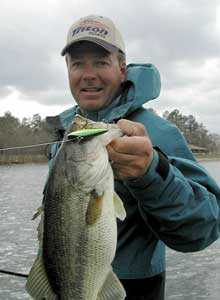
There are two times every year when I look forward to fishing a crankbait. One is immediately after the post-spawn, when bass first start to gang up on offshore ledges.
The other time is March.
It’s definitely one of my favorite times to fish a crankbait because you’re on the front side of the spawn, and fish are just beginning to move in from the deep water where they’ve spent the winter, they’re getting ready to move to the places where they’ll stage up before the spawn, and they’re usually schooled up. And that makes it a really, really good time to catch fish on a crankbait.
What I look for are places where shallow water is close to deep water. These bass, the water has been cold, they’ve been out all winter, and now they’re moving in. They’ve gathered up in bunches, and they’re moving out of the deep water into the kinds of places where you can have your boat in 20 feet of water and reach the bank with a cast without straining too much.
I generally look for the first shallow water between where the fish spend the winter and where they will move into the spawning grounds. I want to fish a place with a hard bottom — whether that means red clay, big rocks, pea gravel or rip-rap. There are a lot of different types of hard bottom that will hold fish — not just big rocks.
One thing I don’t pay a lot of attention to is visible cover. I’m more interested in the bottom.
I look at the edge of the shoreline to see what kind of bottom I can expect to have out off the bank. At Lake Murray, my home lake, I know what the makeup of the bottom is in most every area. At other lakes, it’s a good rule of thumb that what you see at the edge of the shoreline is going to be what you’re fishing out off the bank.
What you do is experiment and fish different kinds of bottoms, and if you find you’ve caught a few fish off a red-clay bottom, then you try and find other places and duplicate what you’ve been doing.
I let the weather conditions dictate exactly where I look first. I keep an eye on my temperature gauge, and if it’s 46 to 50 degrees, I’m more likely to start out on the main lake. If it’s 50 to 55 or 56 degrees, I’m going to look for points at creeks close to spawning areas.
We’ve had a mild winter this year; and if the weather holds, bass’ll be well on their way in March; we may even have some fish spawning by the end of the month.
We’ve had some unusual weather in February and March the past six or eight years. One year, we had fish spawning at the end of February; the next year, it snowed at the end of February. You just have to understand where to look.
A lot of anglers try to fish only clear water early in the spring, but in the Carolinas, if we get the usual rains during the winter and the runoff that follows, it’s about impossible to avoid dirty water.
But you tend to catch fish where you’re more comfortable. Somebody who lives at the lower end of a lake will want to fish where the water is clearer, and somebody who lives up at one of the rivers that feeds the upper end of the same lake will know how to catch fish up there where the water is more likely to be dirty.
I fish different depths of water, so I fish different crankbaits, from a No. 7 Shad Rap to a DT-6 or DT-10, and I fish crawfish colors more: browns, oranges, reds and chartreuses.
I don’t need to make a tremendously long cast like I do when I’m ledge fishing, so I use a 6 1/2-foot, medium-action All-Star Rod, a Pfleuger Supreme bait-casting reel and 10- to 14-pound Trilene XT or Sensation.
One change I make when I’m fishing a crankbait in the spring is to go to a reel with a slower retrieve ratio. I’m a high-speed reel guy, but I drop down to a 5-to-1 ratio reel instead of the 6.3-to-1 reel I normally use.
I think if you can feel the bottom and feel your bait and know what it’s doing, you can fish with any reel, but since you need to be fishing more slowly in March, it’s easier to do when you don’t have to think about it — when the reel helps you do it.
Something I think all bass anglers need to think about in March is the effect that taking bass out of a lake can have on the population. This is a great time to catch large numbers of fish if you can find a place where they’re really grouped up.
I know I’ve caught as many as 40 off one point. If there is ever a time to practice catch-and-release fishing, this is the time.
If you find a place where bass are congregating as they move into a creek to spawn, you can really hurt the fish by keeping too many that are heading back into the creeks to go make more babies.
Besides good numbers, March can be a great time to catch the biggest bass of your life, because the big females are on the move.
I’ll never forget a team tournament I fished with my brother-in-law, Scott Martin, at Lake Murray one year in March. I caught a 10.38-pound fish, and during 95 percent of the tournaments at Lake Murray that will win big fish. They paid two big fish that day, and my fish was third biggest.
That’s still hard for me to believe, that there were two fish bigger than mine caught that day.
But that’s March for you.




Be the first to comment